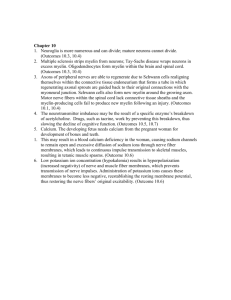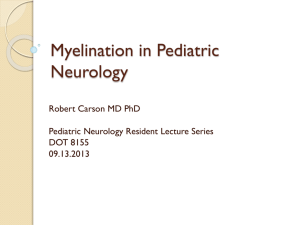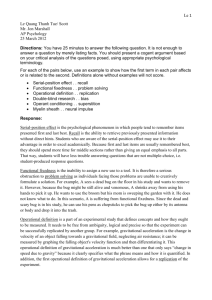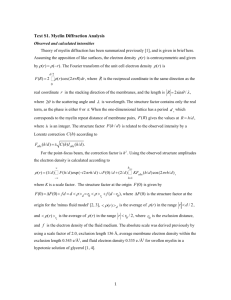October 2004 - Myelin Repair Foundation
advertisement
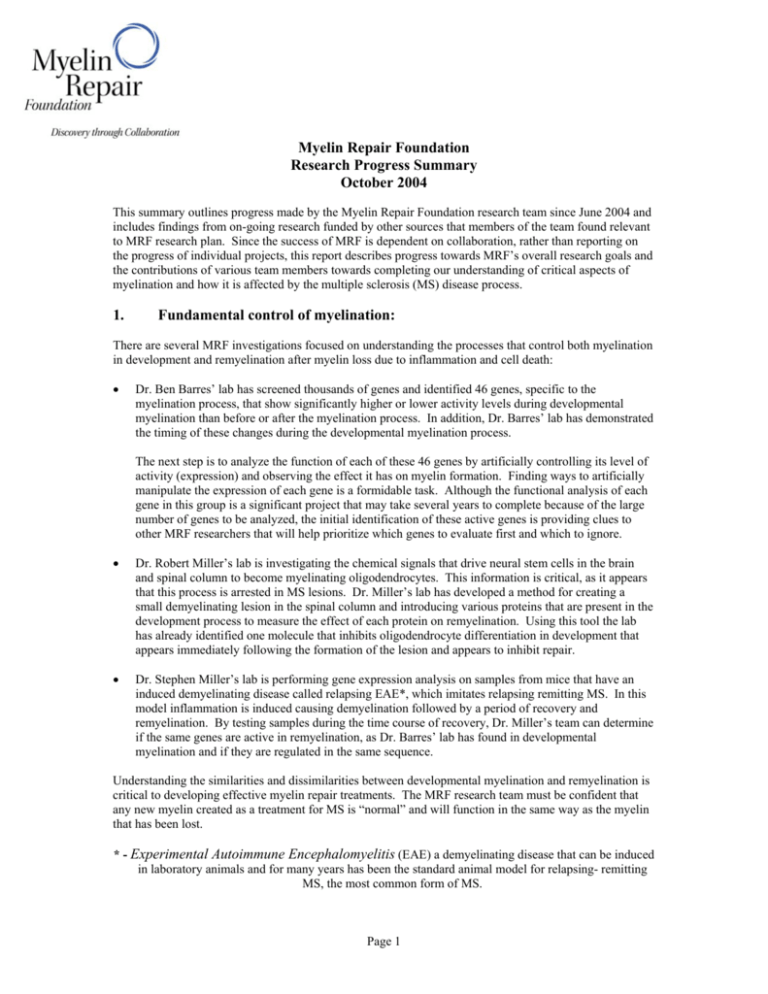
Myelin Repair Foundation Research Progress Summary October 2004 This summary outlines progress made by the Myelin Repair Foundation research team since June 2004 and includes findings from on-going research funded by other sources that members of the team found relevant to MRF research plan. Since the success of MRF is dependent on collaboration, rather than reporting on the progress of individual projects, this report describes progress towards MRF’s overall research goals and the contributions of various team members towards completing our understanding of critical aspects of myelination and how it is affected by the multiple sclerosis (MS) disease process. 1. Fundamental control of myelination: There are several MRF investigations focused on understanding the processes that control both myelination in development and remyelination after myelin loss due to inflammation and cell death: • Dr. Ben Barres’ lab has screened thousands of genes and identified 46 genes, specific to the myelination process, that show significantly higher or lower activity levels during developmental myelination than before or after the myelination process. In addition, Dr. Barres’ lab has demonstrated the timing of these changes during the developmental myelination process. The next step is to analyze the function of each of these 46 genes by artificially controlling its level of activity (expression) and observing the effect it has on myelin formation. Finding ways to artificially manipulate the expression of each gene is a formidable task. Although the functional analysis of each gene in this group is a significant project that may take several years to complete because of the large number of genes to be analyzed, the initial identification of these active genes is providing clues to other MRF researchers that will help prioritize which genes to evaluate first and which to ignore. • Dr. Robert Miller’s lab is investigating the chemical signals that drive neural stem cells in the brain and spinal column to become myelinating oligodendrocytes. This information is critical, as it appears that this process is arrested in MS lesions. Dr. Miller’s lab has developed a method for creating a small demyelinating lesion in the spinal column and introducing various proteins that are present in the development process to measure the effect of each protein on remyelination. Using this tool the lab has already identified one molecule that inhibits oligodendrocyte differentiation in development that appears immediately following the formation of the lesion and appears to inhibit repair. • Dr. Stephen Miller’s lab is performing gene expression analysis on samples from mice that have an induced demyelinating disease called relapsing EAE*, which imitates relapsing remitting MS. In this model inflammation is induced causing demyelination followed by a period of recovery and remyelination. By testing samples during the time course of recovery, Dr. Miller’s team can determine if the same genes are active in remyelination, as Dr. Barres’ lab has found in developmental myelination and if they are regulated in the same sequence. Understanding the similarities and dissimilarities between developmental myelination and remyelination is critical to developing effective myelin repair treatments. The MRF research team must be confident that any new myelin created as a treatment for MS is “normal” and will function in the same way as the myelin that has been lost. * - Experimental Autoimmune Encephalomyelitis (EAE) a demyelinating disease that can be induced in laboratory animals and for many years has been the standard animal model for relapsing- remitting MS, the most common form of MS. Page 1 Research Progress Summary October 2004 2. Structural characteristics of normal myelin: In order to be confident that any newly formed myelin is functionally equivalent to the lost myelin we must first understand the normal structure of myelin. Myelin consists mostly of lipids, the fatty substance that provides insulation. The remainder of myelin is made up of proteins that provide the mechanisms and structures that allow myelin to wrap around the axon. Until now, knowledge of the proteins involved has been limited to a few high abundance proteins that are routinely used to identify the presence of myelin. • Dr. David Colman’s lab has developed a method for separating myelin into its component parts and purifying low abundance proteins that may play critical functional roles in the myelination process. These proteins have been identified and characterized using the most advanced protein analysis technology available, resulting in 132 individual proteins for further analysis. These proteins will be compared to those identified by Drs. Barres’ and Miller’s labs. Proteins that are products of the highly regulated genes identified in Dr. Barres and Dr. Miller’s lab are high probability candidates for being critical to the myelination process. Furthermore, by understanding the timing of expression of these proteins we can begin to understand the sequence of events that leads to normal myelin formation. • Dr. Brian Popko’s lab reported on its initial work in characterizing mice that lack a gene for an unknown protein that results in a severe demyelinating disorder in adults. Dr. Popko’s group is working hard to identify the responsible gene, which may be one of the ones identified in Dr. Barres’ or Dr. Colman’s laboratories. Dr. Popko’s group will study the controlled expression of certain proteins in mice by inserting genes that can be controlled by the introduction of certain drugs to modify the timing of the expression of individual proteins in these mice. Thus, as the other members of the team implicate specific genes or proteins as playing a critical regulatory function in myelin formation, these roles can be verified in live animals. It is important to note that any of the 132 proteins identified in Dr. Colman’s lab may play a critical role at some point in the myelination process. Creating the animal models to test each one could take decades, so it is critical that multiple labs are working together and sharing data to identify and prioritize the best candidates. 3. New animal models for normal remyelination: Oligodendrocytes, the cells that produce myelin in the central nervous system, age and die just like other cells of the body. Thus, outside the area of MS attacks, myelin is constantly being replaced. In order to understand the normal remyelination process, it is important to have an animal model that allows researchers to control the timing and location of demyelination and observe the course of normal remyelination. • Fortunately, Dr. Brian Popko’s lab has been working with such animal models for several years. The lab is exploiting an animal model using Cuprizone, a chemical that when added to the animal’s food selectively kills the oligodendrocytes in the front of the brain, resulting in easily measured clinical symptoms. Once the Cuprizone is removed, the effected area of the forebrain spontaneously remyelinates, with a normal pathology and an absence of symptoms. Using this model, Dr. Popko’s lab is able to observe the role of individual chemical signaling molecules associated with MS inflammation and investigate their impact in retarding or blocking remyelination. The initial results of this research will be published in the next few months and will provide the framework for developing new therapeutic strategies based on the potential benefit of dampening the local inflammatory response. Page 2 Research Progress Summary October 2004 • Dr. Popko’s lab has also developed a second model for selective demyelination based on gene control. In this model, rather than using a chemical substance to kill the oligodendrocytes, genetically modified animals are cross-bred to allow researchers to trigger programmed cell death (apoptosis). This process is similar to what happens during the normal aging process. As with the Cuprizone animals, this process can be turned on and off, allowing the lab to follow the course of remyelination. Other members of the MRF research team have requested that Dr. Popko’s lab investigate ways to create another new animal model wherein new myelin can be identified separately and distinctly from old myelin. While this will be an ongoing area of investigation, Dr. Popko’s team has already surfaced some promising ideas. 4. Promoting myelination in cell culture: Historically, it has been difficult to purify individual cell types from the brain to study their interaction under controlled conditions in culture. For the past several years, Dr. Ben Barres, a pioneer in this area, and members of his lab have been culturing neurons from the central nervous system with oligodendrocytes to see if myelination would take place, without success. Although they have been successful in getting the neurons to extend bundles of axons, the mature oligodendrocytes still fail to myelinate these new axons. • Recently, a developmental pharmaceutical compound was identified by Dr. Barres’ lab that stimulates robust myelination in this culture. This myelination in culture takes the same amount of time as is observed in developmental myelination and the myelin produced appears to be pathologically normal. The number of axons myelinated by each oligodendrocyte in this culture is similar to what is observed in vivo. This discovery is the first potential drug target identified by the MRF research team. • The significance of this finding was reinforced by Dr. Steve Miller’s lab where they recently observed the effects of another compound in this class in their EAE animal model. They found that the introduction of this compound mitigated paralysis and demyelination and reduced the response of T cells, the type of cells responsible for inflammation in MS. The next steps for evaluating this discovery will be to test these compounds on human cells to see if the response is similar and to look for other compounds with similar effect but without the side effects. The results summarized in this report may include findings from research supported by other organizations including the National Institutes of Health, the National Multiple Sclerosis Society and other disease societies. Many of the experimental techniques used by MRF investigators are also the result of past research grants from these organizations. While investigations supported by the MRF are unique, we gratefully acknowledge the contributions to MS research made with the support of these organizations. Page 3
